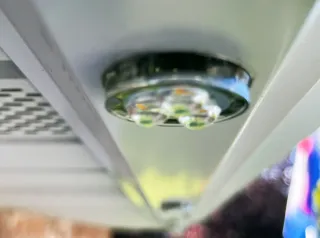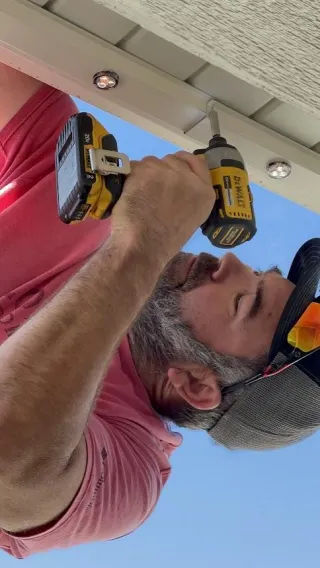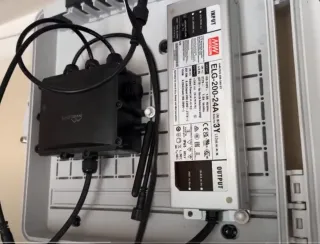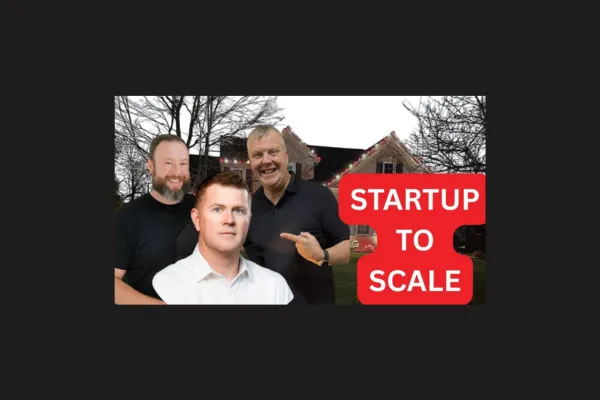Invisilights
Permanent Holiday Lighting
Customizable Lights for Any Event
WHAT YOU NEED TO KNOW BEFORE ORDERING
Total Linear footage of the installation.
This should include footage of lights and channel along with any Extensions or jumps you'll need to make
Where your controller box will be located
This is the most important step to planning out an installation, Without knowing where the controller will be you'll have no way to know the right materials to buy when it comes to extensions and accessories.
What Voltage system you want to use 24V or 36V
This is a decision you will make based on convince and efficiency, the most important factor with this will be the footage of each lighting run. If the total footage of a run is over 100' you'll need to either power inject on that run or switch to the 36V system that can go up to 200' before needing power injection.
Draw a Map
By mapping out the installation you'll be able to better understand and plan out the install giving you a better idea of what all you'll need to purchase to complete the job.
take the measurements from your map and add up the total number of materials you'll need.

For the Map out example above the total material breakdown is:
System Voltage: 36V
Color of channel: Cameo
Channel Type: Hat
Total Lighted Footage: 160'
Power injection: NO
Controller: 1
Channel: 27- 6' sticks
Screws- 200
Lights: 175
1' extensions-7
6' Extensions-2
12' extensions-2
25- extensions- 1
Y Cables- 3
End caps- pack of 10
Absolute necessities
-Controller
-Lights
-Channel
-Screws
-Extension cables
Other Accessories
-Y Cable
-End Caps
- Signal boosters
-Power injection material
When would you need to power inject?
The controller will come with 3 outputs for your lighting runs, each 36V output can do a Max of 200', the 24V system can do a max of 100'. After that max you'll need to inject power. After you do so you can go an additional 100' with the 24V or 200' with the 36V system.
Power injection is needed due to voltage drop, voltage drop happens due to the length traveled away from the power source along with the gauge of the wire. due to the gauge of wire the lights and extensions run on it drops in voltage enough at 100' with the 24V system and 200' with the 36V system to effect the lights performance requiring a addition of power (Power Injection)
Materials needed for power injection 36V
Power injection pig female pig tale
Power injection Extension cables
Power injection T Cable.
Materials needed to Power inject 24V
16/2 - 12/2 Low voltage landscaping wire
Cut and Splice T cable
Water Proof Wire connectors
Discover the Transformative Power of Invisilights: Expertly Installed Permanent Lighting Solutions
Enhance your installation offerings with Invisilights, the premier permanent lighting solution designed for seamless integration into any property’s exterior architecture.
Crafted with high-quality aluminum channels and advanced LED technology, Invisilights delivers durability and superior energy efficiency—key selling points for your clients seeking long-lasting, cost-effective lighting solutions. Our system not only provides brilliant illumination but also boosts the aesthetic appeal and functionality of any home.
Offer your clients peace of mind with our robust 5-year warranty, ensuring reliable performance and minimal maintenance needs. This warranty supports your commitment to quality and customer satisfaction, making it easier for you to sell and install with confidence.
Our flexible, programmable system allows you to meet any client’s specific desires—from subtle accents to full-scale holiday displays—making it an adaptable choice for various applications. With Invisilights, you can cater to a wide range of preferences and needs, increasing your market reach and customer retention.
Choose Invisilights for your installations and add a transformative product to your portfolio that will impress clients and ensure your services remain in demand for years to come.
Frequently Asked Questions
What exactly comes in the 150' InvisiLights permanent outdoor lighting kit?
The InvisiLights kit is comprehensively equipped to ensure you have everything you need for installation. Each kit includes:
27 sticks of 6-foot Aluminum Channel to house and protect the lighting elements.
150 feet of dynamic RGBW LED Lights, which includes 23 sets of 6-count and 14 sets of 1-count lights, allowing for extensive coverage and diverse configuration options.
2 Data Boosters to enhance signal strength across the lighting installation, ensuring consistent control and color output.
A 320W Power Supply capable of supporting up to 190 puck lights, providing ample power for even the most extensive setups.
1 GFCI Outlet Adapter to ensure safe outdoor electrical connections.
1 Controller that allows you to manage and customize the lighting effects easily.

Will I need any additional components besides what's included in the Invisilights permanent lighting kit?
While the Invisilights kit comes with all the essential components for a standard installation, there are a couple of scenarios where you might need additional items:
Jumper Wires: Depending on the layout of your installation and the number of gaps or 'jumps' between the sections of lights, you may require jumper wires. These wires help bridge the gaps without losing the continuity of the light sequence, ensuring a smooth and uniform display across more complex architectures.
Data Boosters: If any section of your lighting setup is more than 15 feet away from the control box, additional data boosters will be necessary. Data boosters help maintain the integrity and brightness of the lights over longer distances, ensuring consistent performance throughout your installation.
Can I choose the color of the aluminum channel for my InvisiLights kit?
Yes, you can select your preferred color for the aluminum channel to match your home’s exterior or personal taste. Please make sure to specify your color choice in the notes at checkout when you place your order.

How do the included components of the InvisiLights kit enhance the lighting system?
Each component in the InvisiLights kit plays a crucial role in creating an effective and stunning lighting display:
Aluminum Channels: Provide a durable, weather-resistant housing for the LED lights, which helps in maintaining a clean and nearly invisible look during the day.
RGBW LED Lights: Offer vibrant, full-spectrum color and white light combinations, making it perfect for any occasion from festive holidays to elegant ambient lighting.
Data Boosters: Ensure that the signal remains strong across longer distances, which is crucial for larger installations.
Power Supply: Designed to efficiently handle the energy needs of the system without overload, ensuring safety and durability.
GFCI Outlet Adapter: Adds an extra layer of safety by protecting against electrical shorts and surges, particularly important in outdoor settings.
Controller: Provides the flexibility to customize and control the lighting sequences, colors, and patterns right from your smartphone or controller, adding convenience and advanced functionality to your lighting system.

Can I use Invisilights year-round?
Absolutely! Invisilights are designed for versatile use throughout all seasons. Whether you're celebrating a special occasion, setting a mood for a party, Love your favorite sports team, or simply enhancing your home's ambiance, our lighting systems provide the perfect solution for any event, big or small.

Can I set timers and events for Invisilights?
Yes, Invisilights feature advanced programmable settings that allow you to schedule lighting for specific events and automate timers. This functionality ensures that your lighting preferences are perfectly aligned with your lifestyle, turning on and off at predetermined times without any manual intervention.

Is it possible to achieve warm or soft white with Invisilights?
Absolutely, Invisilights are equipped with RGBW technology, which includes a dedicated white LED alongside the standard red, green, and blue LEDs. This addition allows the system to produce authentic warm white, soft white, and various other shades of white with greater accuracy and intensity compared to traditional RGB systems. This capability ensures that you can effortlessly tailor the lighting to fit the desired ambiance and aesthetic of any environment, providing precise control over both vibrant colors and the subtlety of different white tones.

How do you ship your product?
Our products are shipped directly from our warehouse using reliable shipping carriers to ensure timely and safe delivery. Each product is securely packaged to prevent damage during transit, and we provide tracking information so you can follow your order’s journey to your doorstep.
Where are the controller and power supplies installed?
The controller and power supplies for Invisilights are typically installed in an accessible location such as a garage or utility room. These components connect to your home’s WiFi network, allowing seamless control over the lighting system via our user-friendly mobile app.

How long do Invisilights last?
Invisilights are engineered to last, with each LED bulb boasting a lifespan of over 50,000 hours. Given a typical usage of 10 hours per night, this translates to approximately 5,000 nights. This means your Invisilights could illuminate your home's exterior for nearly 14 years under these conditions, ensuring that your investment not only adds beauty but also long-term value to your property.

Are Invisilights dimmable?
Yes, all Invisilights are fully dimmable. This feature allows you to adjust the intensity of the light to suit various occasions, from a soft glow for a romantic evening to bright, vibrant colors for a festive celebration.

What types of custom channels are available?
Invisilights offers two types of custom channels, available in 40 different colors, ensuring a nearly invisible installation. These channels are designed to blend seamlessly with your home’s architecture, providing discreet yet effective lighting.

Can I control different zones independently?
Yes, the Invisilights system supports multiple zones which can be controlled independently or synchronized. This functionality allows for intricate lighting designs that can vary across different areas of your home, enhancing the overall impact and utility of your installation.

What is outdoor permanent lighting?
Permanent lighting refers to architectural-grade lighting systems that are installed permanently on your property to provide year-round illumination.
How does permanent lighting differ from traditional holiday lighting?
Unlike traditional holiday lighting, which is typically temporary and used only during specific seasons, permanent lighting is installed once and can be used throughout the year for various occasions

Discover Expert Tips on Our Blog

The Mindset Revolution: How Thinking Bigger Transforms Your Service Business
The difference between a struggling service business and a thriving enterprise often comes down to one critical factor: mindset. While most business owners focus obsessively on tactics, tools, and techniques, the most successful entrepreneurs understand that their greatest asset—and biggest limitation—exists between their ears. This comprehensive guide explores how shifting your mindset can transform not just your business results, but your entire approach to entrepreneurship and wealth building.
The Million-Dollar Ceiling: Breaking Through Mental Barriers
Many entrepreneurs unknowingly create their own glass ceilings, and the pattern is remarkably consistent across industries. As one successful business owner reflected, "I always thought, man, if I can get to a million dollars, you know, I've accomplished something. And I think anyone who starts a business, that's probably one of their first goals, right? Is get to that million dollar mark."
This goal becomes deeply embedded in their psyche, often from childhood experiences or societal programming about what constitutes success. The challenge isn't the goal itself—it's what happens when you achieve it. Most business owners who reach seven figures find themselves stuck, unable to grow beyond that milestone because they never programmed their minds for larger possibilities. They've achieved what they believed was the pinnacle of success, leaving them without a clear vision for what comes next.
The root of this limitation often traces back to formative experiences. Consider the story of a successful entrepreneur who recalled a childhood memory that shaped his entire approach to wealth. As a young boy at a parade, he witnessed a business owner pay for meals for fifteen kids. Someone mentioned that the man's company did about a million dollars that year, and that number became permanently etched in his mind as the definition of true business success.
These mental barriers create a compound negative effect throughout your business operations. When you don't believe customers will pay premium prices, you undervalue your services. When you can't envision substantial returns on investment, you hesitate to hire quality team members. When opportunities seem "too big" for your current reality, you miss expansion possibilities entirely. The truth is profound yet simple: "the limitations starts from all these things that you think, um, or the plateau or, or the, the, the bar of success."
The most successful entrepreneurs understand that your business will never outgrow your personal vision for what's possible. They recognize that breaking through requires not just changing strategies, but fundamentally rewiring how they think about success, wealth, and possibility itself.
The Psychology of Scaling: From Operator to Owner
One of the biggest obstacles to scaling any service business is the founder's inability to delegate effectively. This stems from a deep-seated belief that they're the only person capable of doing things correctly. While this mindset might serve you in the early stages when attention to detail and quality control are paramount, it becomes the primary limitation preventing growth.
A successful business owner who struggled with this challenge explained his realization: "I'm a problem solver. I solve things very quickly in my mind. So of course, when I see a issue or a problem within my organization, the first instinct I have is like, Hey, here's the solution. You know, that's great, right? It's good that I have solutions and I've solved it. The problem is now everyone's depending on Paul to solve the problems."

This pattern creates a dangerous dependency cycle where team members stop thinking critically and simply wait for leadership to provide answers. The business owner becomes a bottleneck, limiting growth to their personal capacity to solve problems and make decisions. Breaking this cycle requires a fundamental shift in approach, moving from providing solutions to developing problem-solving capabilities in others.
One effective method involves requiring team members to present three potential solutions whenever they bring a problem forward. This approach develops critical thinking skills, builds confidence in decision-making, and gradually reduces dependency on leadership for routine issues. The goal isn't to abdicate responsibility entirely, but to create systems and capabilities that function effectively without constant intervention.
True business scaling requires teaching your team to solve problems independently. As the same entrepreneur discovered, overcoming this challenge required discipline and systematic change. He learned to literally write down reminders to "allow your employees to solve the problems" and placed these notes where he could see them regularly. The repetition helped break the ingrained habit of jumping in with immediate solutions.
The transformation from operator to owner represents one of the most challenging transitions in business growth. It requires letting go of the illusion of control while building systems and people capable of maintaining standards and driving results independently.
The Full-Time Entrepreneurship Transition
Making the leap from employee to full-time entrepreneur involves both financial and psychological preparation. The transition requires more than simply replacing your current income—it demands preparation for the irregular cash flow patterns typical of service businesses and the mental adjustment to life without the security of regular paychecks.
One entrepreneur who successfully made this transition emphasized the importance of financial preparation: "Make sure you have your financial house in order. Make sure you're able to live by a budget, because it's not gonna be getting a paycheck every two weeks or every month or every week. We've gone numerous times while we're waiting on commercial clients to pay without taking a paycheck for a month or two. And then you get a windfall of cash."
The financial preparation extends beyond simply having money in the bank. It requires developing comfort with uncertainty and variable income patterns. Successful entrepreneurs learn to budget conservatively during high-income periods and maintain operations during leaner times. They understand that cash flow in service businesses often follows feast-or-famine cycles, and they prepare accordingly.
The psychological challenges often prove more difficult than the financial aspects. You're exchanging the security of regular paychecks for the uncertainty—and unlimited potential—of business ownership. This transition involves managing income variability, taking full responsibility for all business decisions, handling the isolation that often comes with leadership, dealing with the pressure of others depending on your success, and making the fundamental identity shift from implementer to leader.
Many people struggle with what one entrepreneur termed "golden handcuffs"—the comfort and security of a good job that makes the entrepreneurial leap seem unnecessarily risky. This comfort can be particularly challenging for those coming from high-paying professions with excellent benefits. However, those who successfully make the transition often discover that the freedom and potential of entrepreneurship far outweigh the security of employment.
The key to successful transition lies in planning and preparation. This includes building financial reserves, developing systems that can operate without constant oversight, creating multiple revenue streams within the business, and mentally preparing for the challenges and opportunities that come with full ownership and responsibility.
Investment in Self-Improvement: The Highest ROI Activity
Many service business owners invest heavily in equipment and marketing while neglecting the most important asset: themselves. Self-improvement through books, courses, mentorship, and networking often produces the highest returns of any business investment, yet it's frequently overlooked or underfunded.
The principle behind this investment was clearly articulated by one successful entrepreneur: "most good habits and most success habits are caught not taught." This insight reveals why surrounding yourself with successful people and investing in quality education produces such dramatic results. You absorb mindsets, approaches, and habits through exposure and relationship rather than just through formal instruction.
The compound returns of continuous learning extend far beyond specific skills or knowledge. When you commit to daily learning and immediate application of new concepts, you develop pattern recognition that helps you spot opportunities others miss. You build confidence in your ability to acquire new capabilities quickly, which makes you more willing to take on challenges that stretch your current abilities.
One entrepreneur shared his approach to maximizing learning from events and conferences: "I started focusing more on the people at the event, not the event, you know? And what I found is most of the time I was learning the majority of the things that I was applying in the field, that were making a difference in my life from the people that I was dining with that evening, or that I was hanging out with at the event."
This perspective shift—from consuming content to building relationships—transforms educational investments from expense items to relationship-building opportunities. The most valuable insights often emerge from informal conversations with people facing similar challenges or operating at levels you aspire to reach.
The network effect multiplier explains why investing in quality events and educational opportunities produces returns far beyond the immediate learning. Your network truly does determine your net worth, but not in the superficial way most people think. It's about surrounding yourself with people who think bigger than you currently do, who challenge your assumptions, and who model what's possible.
Building a growth-oriented network requires providing value first, maintaining genuine interest in others' success, being vulnerable enough to share struggles and ask for advice, and consistently following up to nurture relationships over time. The most transformative business insights often come from these cultivated relationships rather than formal training sessions.
Redefining Wealth and Success
As your business grows, your definition of wealth should evolve beyond personal consumption. The most fulfilled entrepreneurs develop a vision for wealth that extends beyond themselves to include family, community, and causes they care about. This broader perspective provides motivation for continued growth long after personal needs are met.
One entrepreneur articulated this evolution beautifully when discussing his expanded vision for success: "if the super car didn't cost you anything, and I just gave it to you, would you take it? I'm like, well, I mean, sure, of course I would take it. He goes, so then it really just comes down to price, right? You don't want it because it comes down. I'm like, well, no, it doesn't. It's just, it would be if you gave it to me, I would think it was nice. I go, really? It's not in my, you know, you gimme a thousand acres. Now we're talking."
This conversation revealed something profound about motivation and vision. When pressed about what he would do with unlimited resources, he began articulating goals around impact, legacy, and the ability to support causes he believed in. The conversation shifted from personal consumption to generational impact, community influence, and the ability to make meaningful differences in areas he cared about.
The billion-dollar mindset isn't about greed—it's about impact and influence. When you think at this level, several fundamental shifts occur in how you approach business decisions, resource allocation, and opportunity recognition. You make different decisions about time and money when you're building for massive impact rather than just personal comfort. You notice possibilities that others miss because you're scanning for larger-scale opportunities. You attract higher-caliber people to your organization because your vision inspires others who share similar ambitions.
This expanded wealth perspective includes building resources that benefit children and grandchildren, using success to improve your local community, elevating standards and practices in your industry, supporting causes aligned with your values, and teaching others to achieve similar success. When your vision extends beyond personal accumulation to encompass broader impact, you tap into motivation sources that sustain effort through difficult periods and provide meaning beyond financial metrics.
Practical Implementation Strategies
Sustainable business growth requires systematic approaches to every aspect of your operation. Most service businesses operate reactively, solving problems as they arise rather than preventing them through proper systems. The entrepreneurs who achieve consistent growth understand that systems create the foundation for scalability.
Creating effective systems begins with documenting current processes, even when they seem simple or obvious. Many business owners resist this step because they believe their operations are too straightforward to require formal documentation. However, systematic approaches to customer acquisition, service delivery, quality control, financial management, and employee development become essential as businesses grow beyond the founder's personal capacity to oversee every detail.
The implementation imperative represents the gap between knowledge and results. Many business owners attend training, read books, and consume content without ever applying what they learn. Success requires immediate action on new insights combined with systematic tracking of results and continuous refinement based on feedback.
One successful entrepreneur emphasized this point: "don't ever look at failure as failure. You know, look at it as, you know, an opportunity again to pull yourself out of it. The Think and Grow Rich, I always, I always say I'm gonna write my own book and it's gonna be think, take action and Grow Rich. The fact is, we, we often don't take action because we presuppose negativity or failure."
This insight reveals why implementation proves so challenging for many business owners. Fear of failure prevents action, which guarantees the very outcome they're trying to avoid. Successful entrepreneurs reframe failure as feedback, treating setbacks as information rather than judgments about their capabilities or potential.
Effective implementation requires using new concepts within forty-eight hours of learning them, testing ideas on a small scale before full implementation, measuring results and adjusting approaches based on data, working with accountability partners who challenge you to follow through, and systematically reviewing what's working and what needs adjustment.
Building the Right Team
As your business grows, your success becomes increasingly dependent on the quality of people you attract and retain. This often requires a fundamental shift in how you think about labor costs versus talent investment. The most successful entrepreneurs understand that paying above-market rates for exceptional people creates returns that far exceed the additional investment.
Strategic hiring involves more than just finding people who can perform specific tasks. It requires identifying individuals who share your values and work ethic, who have the potential to grow with your expanding business, who bring complementary strengths that offset your limitations, and who demonstrate the capability to eventually lead others.
Creating a self-managing organization represents the ultimate goal of team building. This requires developing systems, culture, and leadership capabilities throughout the organization rather than concentrating all decision-making authority at the top. When done effectively, it creates an organization that can operate and grow without the founder's constant presence.
The investment in high-quality people often requires overcoming short-term thinking about costs versus long-term thinking about value creation. Exceptional employees don't just perform tasks—they solve problems, identify opportunities, improve systems, and contribute to culture in ways that compound over time.
The Long-Term Vision
Building for impact rather than just profit creates the foundation for businesses that generate value far beyond their immediate transactions. Whether through employee development, community improvement, or industry advancement, successful entrepreneurs find ways to make lasting positive impacts that extend well beyond their personal involvement.
Eventually, every business owner faces transitions—whether selling the business, passing it to family members, or pivoting to new opportunities. Building with the end in mind ensures your business creates lasting value rather than just personal income. This perspective influences every major decision, from systems development to team building to strategic planning.
The entrepreneurs who achieve extraordinary results aren't necessarily smarter or more talented than others—they simply refuse to accept limitations that others take for granted. They invest consistently in themselves, surround themselves with the right people, and maintain focus on possibilities rather than problems.
Conclusion: The Transformation Begins Now
Your business will never outgrow your personal development. The question isn't whether you have the potential for dramatic growth—it's whether you're willing to expand your thinking to match that potential. The transformation begins with a single decision to stop accepting limitations and start building the business and life you truly want.
Everything else is just implementation. But implementation guided by unlimited thinking, supported by continuous learning, and executed with the help of exceptional people creates possibilities that most entrepreneurs never even consider. The choice is yours: accept the limitations that others take for granted, or join the small group of entrepreneurs who refuse to think small and consistently achieve what others consider impossible.

Q1: I've hit a million dollars in revenue but feel stuck. Why can't I seem to grow beyond this point?
A: You've likely hit what's called the "million-dollar ceiling" - a self-imposed mental barrier that many entrepreneurs face. As one successful business owner explained, "I always thought, man, if I can get to a million dollars, you know, I've accomplished something. And I think anyone who starts a business, that's probably one of their first goals, right?" The problem occurs when you achieve what your mind considers the pinnacle of success, leaving you without a clear vision for what comes next. Break through this by expanding your vision beyond personal goals to include generational impact, community influence, and causes you care about. Start thinking in terms of what you could accomplish with 10x or even 100x your current resources.
Q2: I solve every problem in my business personally, and my team always comes to me for answers. How do I break this cycle?
A: This is a classic control trap that prevents scaling. The issue, as one entrepreneur discovered, is that "when I see a issue or a problem within my organization, the first instinct I have is like, Hey, here's the solution... The problem is now everyone's depending on [me] to solve the problems." Implement the "three solutions method": when employees bring you problems, require them to present three potential solutions along with their recommendation. Initially, you may need to write yourself reminders to "allow your employees to solve the problems" and resist the urge to immediately provide answers. This develops their critical thinking while reducing your involvement in routine decisions.
Q3: I have a well-paying job with benefits, but I want to go full-time with my business. How do I make this transition safely?
A: The transition requires both financial and psychological preparation. Start by getting your "financial house in order" and learning to "live by a budget, because it's not gonna be getting a paycheck every two weeks." Successful entrepreneurs recommend having 6-12 months of expenses saved, since you'll experience periods where you "go numerous times while waiting on commercial clients to pay without taking a paycheck for a month or two." Beyond finances, prepare mentally for income variability, increased responsibility, and the pressure that comes with others depending on your success. The "golden handcuffs" of a secure job are real, but those who make the leap often discover the freedom and unlimited potential far outweigh the security of employment.
Q4: Is investing in courses, coaching, and conferences really worth the money? How do I know I'll get a return?
A: Self-improvement typically produces the highest returns of any business investment. As one successful entrepreneur noted, "most good habits and most success habits are caught not taught." The value often comes less from the content and more from the relationships you build. Focus on "the people at the event, not the event" because "most of the time I was learning the majority of the things that I was applying in the field... from the people that I was dining with that evening." Even when the training itself isn't exceptional, the networking and relationship-building opportunities typically return the investment many times over. Surround yourself with people operating at the level you want to reach.
Q5: I'm hesitant to hire expensive employees. How do I justify paying someone $100,000+ per year?
A: This hesitation often stems from limiting beliefs about what's possible in your business. The key insight is that exceptional employees don't just perform tasks—they solve problems, identify opportunities, improve systems, and contribute to culture in ways that compound over time. When you hire someone who can eliminate bottlenecks, increase efficiency, and free you to focus on high-value activities, the return far exceeds the investment. Consider that if a $100,000 employee helps you capture opportunities worth $500,000 or more, the math becomes obvious. Shift your thinking from "labor cost" to "talent investment" and focus on the value exceptional people create rather than just what they cost.
Q6: I've failed multiple times in business. How do I maintain motivation and not let setbacks derail my progress?
A: Reframe your relationship with failure entirely. As one entrepreneur emphasized, "don't ever look at failure as failure. You know, look at it as an opportunity again to pull yourself out of it." The reality is that "we often don't take action because we presuppose negativity or failure," which guarantees the very outcome you're trying to avoid. Successful entrepreneurs treat setbacks as feedback rather than judgments about their capabilities. When failures occur, immediately ask: "What can I learn from this? How can this experience contribute positively to my future success?" Extract specific lessons, recover quickly, adjust your strategy, and use the experience to build resilience and confidence in your ability to overcome challenges.
Q7: Why should I think about making billions when I'm struggling to reach my first million?
A: Expanding your vision isn't about greed—it's about impact and possibility. When asked what he would do with unlimited resources like Elon Musk, one entrepreneur began articulating goals around supporting causes he believed in and making generational impact. The billion-dollar mindset changes how you make decisions about time, money, and opportunities. You start noticing possibilities others miss, attracting higher-caliber people who share ambitious visions, and building for long-term impact rather than short-term comfort. Even if you never reach billions, thinking at that level eliminates artificial limitations and opens up possibilities you never would have considered with smaller thinking.
Q8: I read business books and attend training, but I struggle to implement what I learn. How do I bridge this gap?
A: The gap between knowledge and results is implementation, and most people consume information without applying it. Develop a systematic approach: use new concepts within 48 hours of learning them, test ideas on a small scale before full implementation, measure results and adjust based on data, work with accountability partners who challenge you to follow through, and regularly review what's working versus what needs adjustment. Remember that "think, take action and grow rich" is more accurate than just thinking about growing rich. Implementation requires overcoming the tendency to "presuppose negativity or failure" and taking action despite uncertainty about outcomes.
Q9: My business operates reactively, solving problems as they arise. How do I create systems that allow for real growth?
A: Sustainable growth requires systematic approaches to every aspect of your operation. Start by documenting your current processes, even when they seem simple or obvious. Develop systems for customer acquisition (predictable methods for generating qualified leads), service delivery (standardized processes ensuring consistent quality), quality control (mechanisms for maintaining standards as you scale), financial management (tracking profitability and cash flow), and employee development (structured approaches to training and advancement). Most service businesses resist systematization because they believe their operations are too straightforward, but systems become essential as you grow beyond your personal capacity to oversee every detail.
Q10: How do I build a business that creates lasting impact beyond just making money?
A: Start by expanding your definition of wealth beyond personal consumption to include generational impact, community influence, industry leadership, philanthropic goals, and knowledge transfer. This broader perspective provides motivation for continued growth long after personal needs are met. Build your business with the end in mind, considering how it will create lasting value whether you sell it, pass it to family, or transition to new opportunities. Focus on developing people, improving your community, elevating industry standards, and teaching others to achieve similar success. When your vision extends beyond personal accumulation to encompass broader impact, you tap into motivation sources that sustain effort through difficult periods and provide meaning beyond financial metrics.
Copyright ©2025 All Right Reserved website designed by christmaslights.io
Terms of Service / Privacy Policy
Have questions or need assistance?
Contact us at (855)619-LITE





